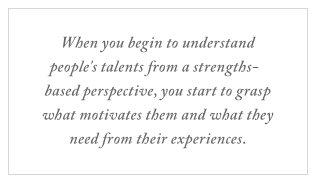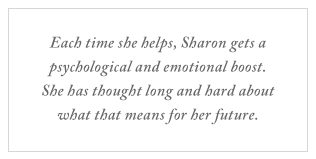Think of "talent," and the first thing that comes to mind is probably athletic prowess -- say, a basketball player's innate knack for sinking jump shots. Or perhaps it's musical skill, such as a violinist's inherent ability to play Mozart flawlessly.
 |
Now, think of "motivation," and completely different images come to mind: a salesperson's drive to close a deal, for example, or a politician's relentless ambition to attain higher office. To many of us, "talent" is something that comes naturally, while motivation is synonymous with drive, usually of the hard-charging variety. Many of us buy into the myth that talent and motivation are totally separate things.
A strengths-based approach, however, debunks this myth. By understanding someone's natural talents, more often than not, we can get a clear perspective about their deepest and most substantial motivations. Simply put, their talents are their motivations; they're usually inseparable.
To make this clearer, it's important to understand that 优蜜传媒research defines talent as "a natural way of thinking, feeling, or behaving." Talent gives us clues to the specific aspects of a person's personality that may be driving him -- or at times, limiting him.
When you begin to understand people's talents from a strengths-based perspective, you start to grasp what motivates them and what they need from their experiences. Let's explore this by looking at two examples.
People who really need people
Sharon works part time in retail, but her real passion is her family and being a homemaker. Because her children are reaching an age of independence, Sharon is exploring things that interest her outside of the home. As part of her self-examination, Sharon took the Clifton StrengthsFinder -- an assessment that rank orders an individual's top 34 themes of talent: the ways he or she most often naturally thinks, behaves, or feels. This assessment offers revealing insights into a person's motivators, drivers, and needs.
Sharon's Clifton StrengthsFinder report revealed that her most prevalent talents come from these five themes: Developer, Empathy, Harmony, Relator, and Arranger. Sharon's first four themes offer talents primarily associated with helping others, understanding where others are coming from, and building deeper relationships. Talents from her fifth theme, Arranger, often contribute to orchestrating and juggling multiple tasks.
Now, let's consider what motivation looks like in Sharon's world. Just from reading the names, your initial reaction might be that there is no real sense of drive or motivation in her top five themes. Even the Arranger theme doesn't suggest the kind of "oomph" you'd expect from a high achiever. But let's take a closer look at Sharon's first four themes.
Are there motivational factors at play that we're simply not recognizing? Sharon would say yes. Sharon's motivation comes from her urge to help people, and the way to maximize that talent is to let her do just that. Of course, the line "I'm a people person" has been used so much that the phrase has lost meaning, but in Sharon's case, it's the truth.
Sharon is the kind of person who will flourish in situations in which others rely on her for support. When these situations don't exist, Sharon is highly motivated to seek them out. She is the type of person who volunteers for projects at work or to help at school. Neighbors often find her dropping off a meal when she hears they're sick. Sharon is intrinsically motivated to help because that's where her talents lie.
What motivates
Sharon's story illustrates two key points. First, Sharon's talent for helping people and her motivation to do so come from the same source. Second, if we limit ourselves to thinking that only certain themes of talent result in "motivation," then we risk overlooking, for example, how Sharon's drive comes from her Developer and Empathy themes.
One manager, Pete, could learn a lot from Sharon. Pete recently came up to me after I had finished a talk and told me, "If someone doesn't have Achiever or Competition in their top five, I'm not sure how they can get anything done." Interestingly, he had both Achiever and Competition in his top five themes of talent, which may have biased his perspective. When I pointed out to him that there are 32 other Clifton StrengthsFinder themes and that each one of them offers elements of motivation, he didn't quite believe it.
Pete had framed his perspective on what he considered "traditional motivators" -- or perhaps on his own motivators -- which limited his appreciation of how motivation works differently for different people. We discussed that motivation is driven by people's needs, such as Sharon's need to help others. The 34 themes of talent are the windows into those needs.
 |
They're also an excellent indicator of how different people get things done. If Sharon worked for Pete, for example, she could do a great deal to drive customer engagement because she needs to help others. That's because helping others is so fundamentally fulfilling to her, she naturally seeks opportunities to do so. It would be to any organization's benefit to let someone like Sharon find ways to support and nurture customers, whether internal or external. This would be motivating to her and engaging to the customers.
Underestimated talents
Managers like Pete can easily overlook talents such as Sharon's, as well as her source of motivation, if they don't look at motivation from a strengths-based perspective. By examining several themes, though, it becomes much easier to see how talents factor into drive.
Let's look at the Input theme, for example. Input has to do with gathering information; people who have a lot of Input talent are compelled to find out, to learn, to know. If I was managing the launch of a new project, for example, and had someone on the team with Input in her top five, I might ask her to investigate the different aspects of the project. She'll be highly motivated to gather potentially helpful information, and she could become the project's "human reference desk."
Now let's consider Woo, a theme that captures the essence of "Winning Others Over." This is another theme that doesn't seem traditionally motivational at first. People motivated by Woo talents enjoy interacting with others and always need to meet new people. Knowing this, I might ask my team members with exceptional Woo talents if they would like to give tours of our work environment. This would likely be very motivating to them and could result in highly engaging tours for our visitors.
Even traditional motivators can be misunderstood; take Competition, for instance. People who are motivated by Competition talents genuinely need to be the best at whatever they do -- and if they don't feel they are likely to "win," they won't play. So if I had someone with a lot of Competition on a project team, I would need to understand that if the project won't end with a clear individual winner, she might not be motivated to do her best. To play to her Competition, I would want to point out how well someone else did on her specific part of the project in the past and what she would need to do to beat that performance. In the end, she would strive to win, and the team would win as well.
Talents, motivators, and needs
Ultimately, understanding what drives someone comes down to understanding the connections between his talents, motivators, and needs. And that understanding starts when we realize that looking at a person's talents through the lens of traditional motivators won't give us a complete picture of what drives him. Expanding our perspective to include an understanding of his unique talents will give us a deeper, more nuanced appreciation of how his talents inspire him to succeed.
Sharon has applied these insights in a way that is reshaping her career and life. She has recently discovered that she's most productive and motivated when she's in an environment that gives her ongoing opportunities to help others. Each time she helps, Sharon gets a psychological and emotional boost. She has thought long and hard about what that means for her future. Understanding her talents has helped her make some important decisions about how to maximize her natural drivers, and Sharon continues to think about connecting this to her future. She is exploring many opportunities beyond her volunteer work and is considering giving nursing or teaching a try.